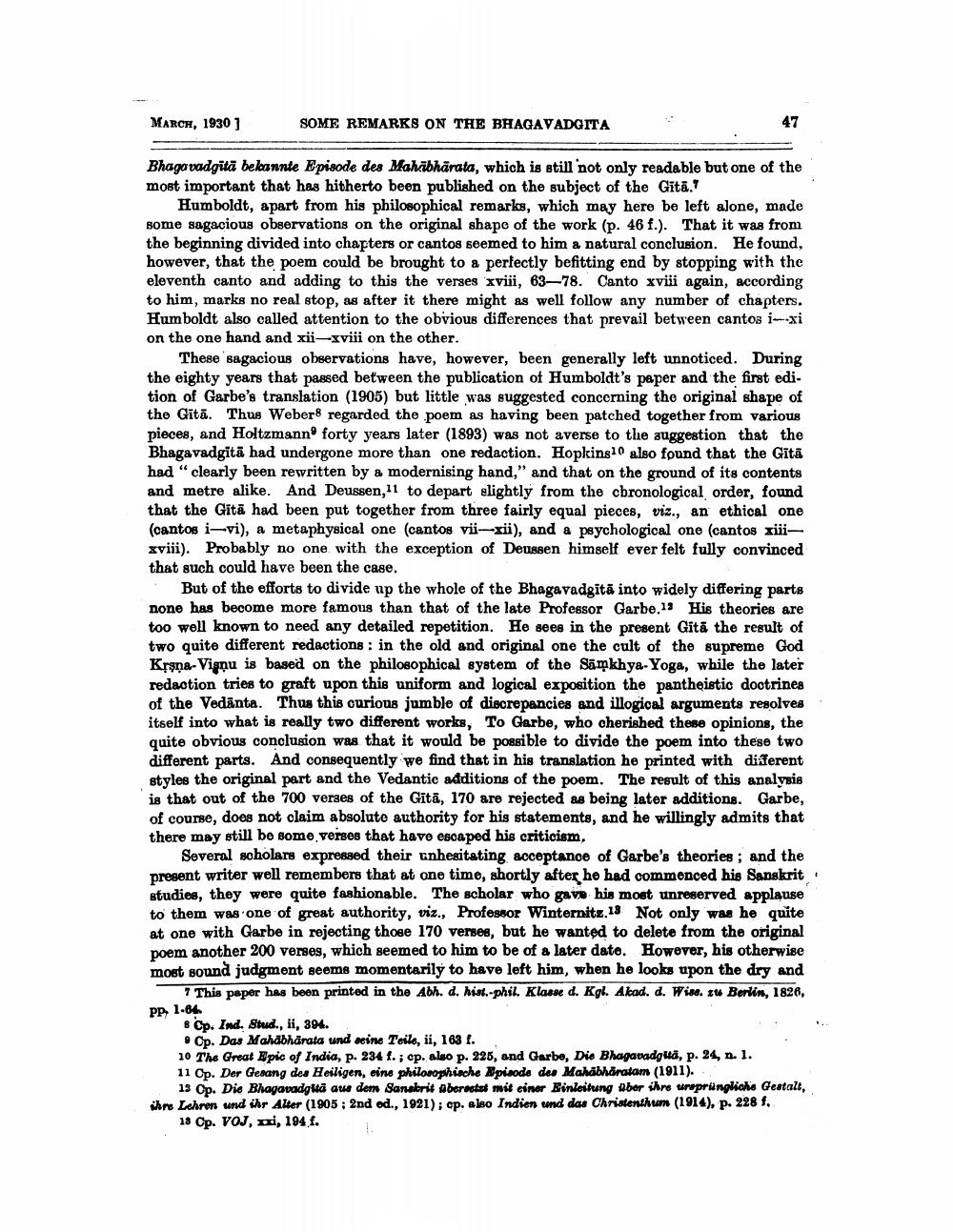________________
MARCH, 1930 ]
SOME REMARKS ON THE BHAGAVADGITA
Bhagavadgita bekannte Episode des Mahabharata, which is still not only readable but one of the most important that has hitherto been published on the subject of the Gitā.7
Humboldt, apart from his philosophical remarks, which may here be left alone, made some sagacious observations on the original shape of the work (p. 46 f.). That it was from the beginning divided into chapters or cantos seemed to him a natural conclusion. He found, however, that the poem could be brought to a perfectly befitting end by stopping with the eleventh canto and adding to this the verses xviii, 63–78. Canto xviii again, according to him, marks no real stop, as after it there might as well follow any number of chapters. Humboldt also called attention to the obvious differences that prevail between cantos i-xi on the one hand and xii-xviii on the other.
These sagacious observations have, however, been generally left unnoticed. During the eighty years that passed between the publication of Humboldt's paper and the first edition of Garbe's translation (1905) but little was suggested concerning the original shape of the Gītā. Thus Weber8 regarded the poem as having been patched together from various pieces, and Holtzmanno forty years later (1893) was not averse to the suggestion that the Bhagavadgitā had undergone more than one redaction. Hopkins10 also found that the Gītā had"clearly been rewritten by a modernising hand," and that on the ground of its contents and metre alike. And Deussen, 11 to depart slightly from the cbronological order, found that the Gītā had been put together from three fairly equal pieces, viz., an ethical one (cantos i--vi), a metaphysical one (cantos vii-xii), and a psychological one (cantos xiiixviii). Probably no one with the exception of Deusgen himself ever felt fully convinced that such could have been the case.
But of the efforts to divide up the whole of the Bhagavadgitā into widely differing parts none has become more famous than that of the late Professor Garbe.13 His theories are too well known to need any detailed repetition. He sees in the present Gită the result of two quite different redactions : in the old and original one the cult of the supreme God Krşna-Vişnu is based on the philosophical system of the Samkhya-Yoga, while the later redaction tries to graft upon this uniform and logical exposition the pantheistic dootrines of the Vedānta. Thus this curious jumble of discrepancies and illogical arguments resolves itself into what is really two different works, To Garbe, who cherished these opinions, the quite obvious conclusion was that it would be possible to divide the poem into these two different parts. And consequently we find that in his translation he printed with different styles the original part and the Vedantie additions of the poem. The result of this analysis is that out of the 700 verses of the Gita, 170 are rejected as being later additions. Garbe, of course, does not claim absoluto authority for his statements, and he willingly admits that there may still bo some verses that have escaped his criticism,
Several scholars expressed their unhesitating, acceptance of Garbe's theories ; and the present writer well remembers that at one time, shortly after he had commenced his Sanskrit studies, they were quite fashionable. The scholar who gave his most unreserved applause to them was one of great authority, viz., Professor Winternitz,18 Not only was he quite at one with Garbe in rejecting those 170 verses, but he wanted to delete from the original poem another 200 verses, which seemed to him to be of a later dato. However, his otherwise most sound judgment seems momentarily to have left him, when he looks upon the dry and
7 This paper has been printed in the Abh. d. hist.-phil. Klasse d. Kgl. Akad. d. Wiss. su Berlin, 1826,
Pp, 1-64.
8p. Ind. Stud., ii, 394.
Cp. Das Mahabharata und seine Teile, ii, 108 1. 10 The Great Epic of India, p. 234 1. ; cp. also p. 225, and Garbe, Die Bhagavadgita, p. 24, n. 1. 11 Op. Der Gesang des Heiligen, cine philosophische Episode des Mahabharatam (1911).
13 Op. Die Bhagavadgita aus dem Sanskrit aberastet mit einer Einleitung über ihre ursprüngliche Gestalt, ihre Lehren und ihr Alter (1905 ; 2nd ed., 1921); cp. also Indien und das Christenthum (1914), p. 228 f.
18 Op. VOJ, , 194 f.




